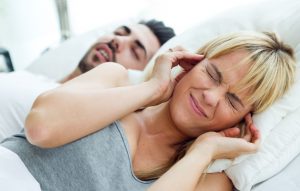Snoring affects 35 to 45 per cent of men and 15 to 30 per cent of women, whereas sleep apnoea, also known as obstructive sleep apnoea (OSA), is less common, affecting only three to five per cent of adults. Snoring and sleep apnoea are at two ends of the spectrum of a condition called sleep disordered breathing.
Snoring is noisy breathing which affects the partner more than the person snoring and can cause relationship difficulties. On the other hand, sleep apnoea could have a detrimental effect on the health of the individual, if untreated.
Both conditions are caused by increased resistance to the airway when asleep. In mild cases it causes noisy breathing (snoring) but severe obstruction can cause cessation of breathing, leading to a decrease in oxygen concentration in the blood, which corrects itself when normal breathing resumes. This can happen multiple times a night, leading to disturbed sleep.
We asked Mr Prasad Kothari, Consultant ENT Surgeon at One Hatfield Hospital, to tell us what can be done to help individuals (and their partners) to get a better night’s sleep.
How do I know if I have sleep apnoea?
Mild sleep apnoea may go undetected for a long time. Most patients who have apnoea are aware of disturbed sleep and wake gasping for breath many times. If sharing a bed, your partner would usually notice breath-holding episodes. Patients complain of excessive daytime tiredness and sleepiness (known as somnolence). This can result in poor attention span and inability to concentrate at work. If untreated, sleep apnoea can have harmful effects on health, leading to cardiac and neurological problems.
Snoring, on the other hand, has very little effect on one’s health in the long term but can impact social and marital life, as the snoring noise may discourage partners from sharing the bedroom.
What causes snoring and sleep apnoea?
Snoring is more common in men than in women, while both conditions are more common in one’s 40s and 50s. Post-menopausal women also have a slightly higher incidence of snoring. Increased weight (BMI over 25) is associated with both conditions and severity of apnoea increases with increase in weight. There are also structural causes, like nasal blockage due to polyps or a deviated nasal partition. Large tonsils can narrow the airway, causing partial obstruction of the throat and can contribute to both conditions.
How is sleep apnoea diagnosed?
A clear history and detailed examination of the mouth and throat will help diagnosis. There are free apps that can also help patients to self-diagnose, although not all apps are validated and therefore they may not be accurate. A specialist may arrange a sleep study, which will not only confirm sleep apnoea but also diagnose its severity.
Can it be treated?
Treatment for sleep apnoea depends on severity. Weight reduction and lifestyle changes like reducing alcohol intake and breathing exercises may help with mild to moderate conditions. Surgery to remove nasal polyps or tonsils can sometimes help. More severe cases may require long-term treatment with a breathing device called CPAP. This drives air into the airway via a face mask worn while sleeping. If snoring is the main symptom, surgery can be considered, under general anaesthetic.
Some devices on the market claim to stop snoring, but one has to be cautious about claims that are not clinically proven. A mandibular (jaw) splint may offer benefits if used appropriately but it is not suitable for everyone.
What about children?
Snoring and sleep apnoea are common in children and in the vast majority of cases this is due to enlarged tonsils and adenoids. Some children grow out of the problem, but some will require surgery to remove the tonsils and adenoids.


 One Ashford
One Ashford One Hatfield
One Hatfield